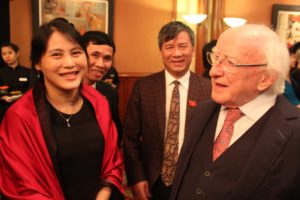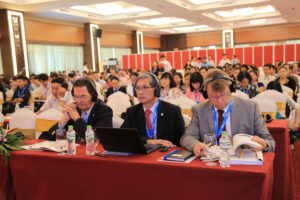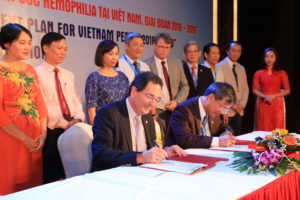The Irish Haemophilia Society (I.H.S.) have been working with and collaborating with the Vietnam Hemophilia Association (VHA) since 2010. Back then, haemophilia treatment in Vietnam, was mainly with cryoprecipitate, which is a much less effect form of therapy. Access to factor concentrates was very limited. In 2010, 2.7 billion international units (iu) of factor concentrates were used this equates to a meagre 0.032iu per capita (as a comparison in 2010 Ireland used approximately 6.5iu per capita or some 200 times more per head of population than Vietnam). In 2010 the Vietnam Haemophilia Association was called the Vietnam Society for Congenital Bleeding Disorders, it was run by the doctors with very little or no involvement by patients. Their organisation was run by a very large executive committee. They had key leaders, empathetic and caring doctors and a good pool of people with haemophilia and parents who were willing to get involved in the organisation. The twinning programme officially started at the end of 2010. This was originally a four-year programme which was to run until the end of 2014. Each year the Irish Haemophilia Society made two visits to Vietnam and some of the leaders of the haemophilia organisation in Vietnam visited Ireland. We defined action plans for each year and set objectives:
2011 Activities:
In 2011, our activities with Vietnam included:
-
A board development workshop attended by 50 people.
-
A volunteer development workshop attended by 30 volunteers in Hanoi – a roster of volunteers was established whereby volunteers committed to one full day per month working with the centre and assisting patients in the hospital.
-
An action planning working was carried out as part of the board governance workshop, Garvan Mc Cann from the Irish Embassy attended the closing of the volunteer workshop.
2012 Activities:
In 2012, our activities included:
-
The identification and preparation of suitable publications to be translated into Vietnamese.
-
A workshop on organising of events for the association.
-
Task lists for volunteers.
-
Workshops for chapter leaders.
-
Task lists for newly appointed staff at the newly renamed VHA.
-
At the end of 2012, a new governance structure was approved with a streamlined executive board and the renaming of the organisation to the VHA.
2013 Activities:
In 2013, a further action workshop took place with the new executive board of the VHA and visits were made to Hai Duong and Hung Yen.
2014 Activities:
In 2014, workshops were held for chapter leaders.
-
A workshop was held on fundraising.
-
A visit was made to the chapter in Hung Yen.
-
We started a home adaptation project which was to be rolled out in Hanoi, Ho Chi Minh, Hai Duong and Hung Yen.
-
We also initiated a micro employment project.
In 2014, the Irish Haemophilia Society staff team provided training to the new VHA staff member. New publications on dental care for adults and children were produced in Vietnamese. New treatment guidelines were agreed by the Ministry of Health in May 2014. By the end of 2014, which was the original date for completion of the programme, the partnership between the Irish Haemophilia Society and Vietnamese Hemophilia Association had been very successful. During that time the I.H.S visited Vietnam on eight occasions and the VHA visited Ireland on three occasions. Close collaboration and close relationships were established between the doctors and patient organisation leaders in Vietnam and the Irish Haemophilia Society.
The key outcomes included the following:
-
The structure and governance of the VHA was strengthened.
-
The organisation was renamed the Vietnam Hemophilia Association with a new streamlined executive board structure comprising of 13 members representing Hanoi, Hue and Ho Chi Minh and includes doctors, people with haemophilia and parents.
-
New branches of the VHA were established in HCMC and Hai Duong.
-
Three Haemophilia Clubs/Chapters were established in Hung Yen, Hai Duong and Thi Binh Province.
-
A large number of volunteers were trained in Hanoi and HCMC to work with the hospitals and the VHA.
-
Additional staff were appointed to the VHA and trained with the assistance of the I.H.S.
-
Training was provided to the patients who lead the chapters.
-
Peer groups were established for mothers, fathers and young men with haemophilia in Hanoi.
-
The VHA were successful in obtaining additional funding for activities from pharmaceutical companies.
-
The National Institute for Haematology and Blood Transfusion in Hanoi now has a roster of more than 20 volunteers who work with them on a regular basis.
-
Specific publications were provided.
-
Strategic planning and action planning workshops were carried out with the VHA board.
-
Training was provided on fundraising and event management.
-
Specific task lists were agreed for volunteers and chapter leaders and VHA staff.
-
A home adaptation project was funded by the I.H.S, this allowed for the purchase of a small number of adaptive toilets and a large number of crutches and wheelchairs.
-
The I.H.S. also funded a micro employment project – given the fact that many patients in Vietnam have severe joint problems due to inadequate treatment in the past many of them could not leave their home to go to work. Therefore we looked at situations where some assistance could be given to them to work in their home environment. The micro employment project included the purchase of sewing machines, assistance in opening an electric repair shop, assistance in opening a tailor shop and a grocery store.
Clinically, thanks to the strong leadership of Professor Nguyen Anh Tri, Director of the NIHBT, treatment for people with haemophilia in Vietnam continued to improve.
-
The Ministry for Health approved treatment on demand for bleeding episodes and some access to home therapy. They also approved the provision of prophylaxis for the treatment of severe haemophilia for people who are less than 15 years old. This is not yet a reality but it has been approved.
-
There are now seven hospitals who provide haemophilia care – two in Hanoi, three in HCMC, one in Hue and one in Can Tho.
-
The state medical insurance coverage for haemophilia medications has improved with specific coverage agreed in 2012 and 2014.
-
The number of patients with haemophilia now managed by the NIHBT in Hanoi has increased from 830 in 2010 to 1,236 in 2014.
-
Factor Concentrate use, despite still being low, doubled between 2009 at 0.032iu per capita to 0.073iu per capita in 2013
In 2015, the I.H.S. persuaded the WFH to consider Vietnam for their Global Alliance for Progress Programme (GAP). This comprehensive programme aimed to build sustainable care in a country for haemophilia care it focuses on six areas:
-
Increasing government support.
-
Care delivery.
-
Medical expertise.
-
Provision of treatment products.
-
Improvement in the patient organisation.
-
Data collection and outcomes research.
We visited Vietnam with the WFH President and CEO in 2015 and had a successful meeting with the Deputy Minister for Health, Nguyen Thi Xuyen. The Deputy Minister declared the Ministries support for the national haemophilia programme and their support for Vietnam becoming a GAP country. The GAP Programme started this year in Vietnam and will run until at least 2019. We will work with WFH and the VHA on the implementation of this programme to the completion of the programme. The main objective of the GAP are as follows:
-
Ensure continuation of Government support for national haemophilia care programme.
-
Improve care delivery in the country by strengthening the existing network of seven haemophilia treatment centres and creating satellite centres.
-
Support the development of medical expertise of HCP’s in selected centres and in general in the country.
-
Increase the supply of factor concentrates for patients.
-
Expand the patient organisation and increase its lay leadership and the number of active volunteers.
-
Develop and implement a national registry.
-
A minimum of 10 additional centres will be developed during the course of this programme. The core team and services will also be strengthened and developed at centres in Hanoi, HCMC, Hue and Can Tho.
-
The expertise of the I.HS. will be utilised in establishing a national tender procurement system for factor concentrates for Vietnam so that they can access these expensive medications on a more cost effective basis for the whole country.
-
Of note is the fact that due to their acceptance of the GAP Programme that Vietnam are now in receipt of several million international units of the latest longer acting factor concentrates free of charge under the WFH Humanitarian Programme – we anticipate that they will receive approximately 5 million euros worth of free medication per year during the curse of the GAP Programme.


